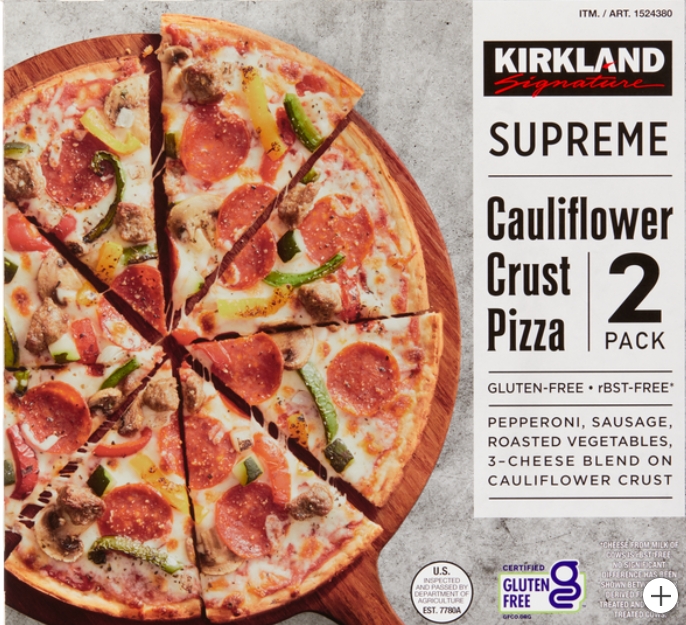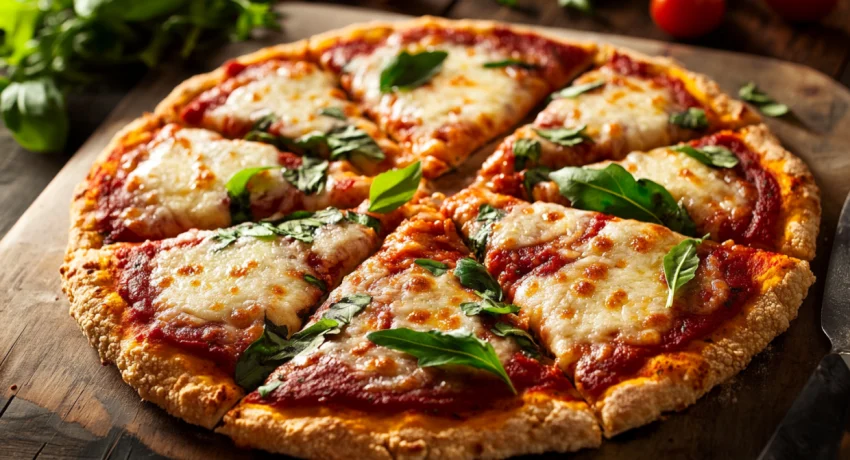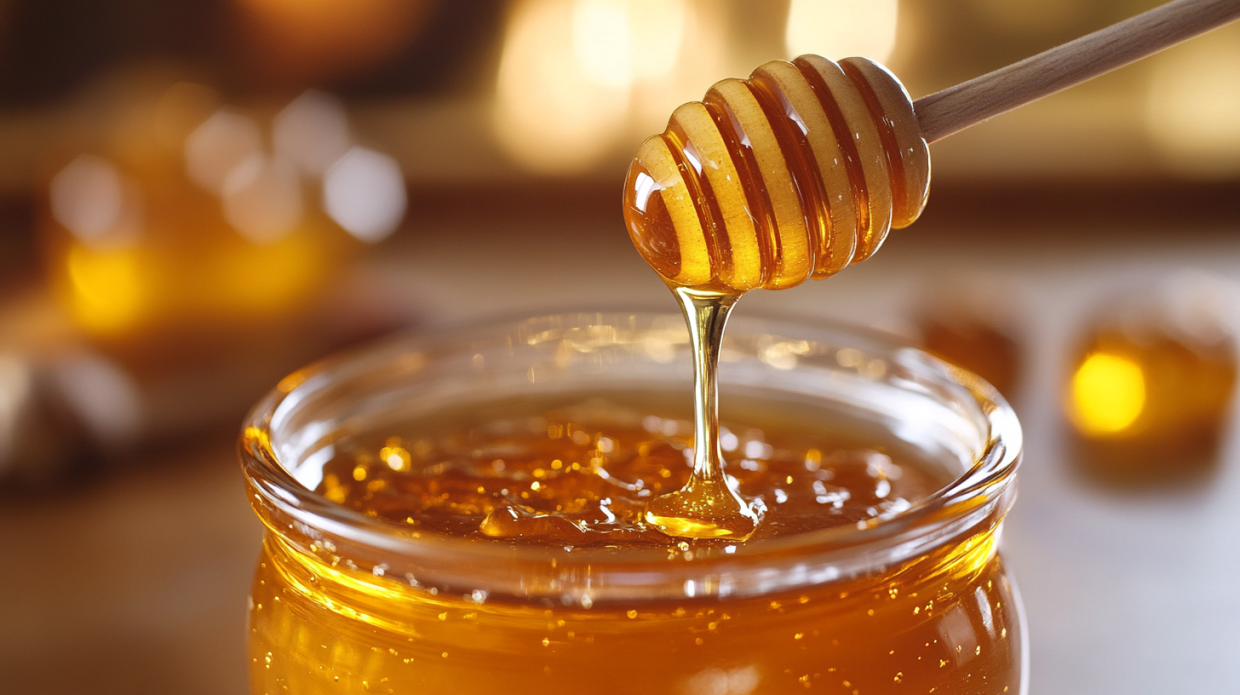
Kirkland Signature Cauliflower Crust Pizza, Supreme, 2 ct
- Crispy cauliflower crust topped with a rich tomato sauce, mozzarella cheese, and a combination of zesty pork pepperoni and seasoned sausage
- Add roasted vegetables, mushrooms, onions and zucchini to create perfect harmony
- Finish with Parmesan and Romano cheeses for balance
From Skeptic to Convert: My Three-Month Love Affair with Costco’s Hidden Gem
In the ever-evolving landscape of alternative food options, Kirkland Cauliflower Pizza has emerged as a game-changer for anyone seeking the perfect balance of flavor and nutrition. As someone who once scoffed at the very concept of a vegetable masquerading as my beloved pizza crust, I’m here to share how this frozen delight from Costco transformed not only my weeknight dinner routine but also my perspective on what “healthy eating” can actually taste like.
Let’s dive into everything you need to know about this increasingly popular product that’s flying off Costco shelves nationwide.
The Curious Case of Cauliflower Crust: What’s Actually in This Thing?
My journey began with skepticism and a simple question: what exactly am I eating? Kirkland Signature Cauliflower Pizza doesn’t try to hide its ingredients, and that transparency is refreshing in today’s food market. The star of the show is, of course, cauliflower, which forms the foundation of the crust along with rice flour, mozzarella cheese, potato starch, olive oil, and egg whites.
The cauliflower base provides that satisfying texture we crave in pizza while significantly reducing the carbohydrate content compared to traditional wheat-based crusts. For those monitoring specific ingredients, it’s worth noting that while the crust contains dairy (in the form of mozzarella) and eggs, it doesn’t contain wheat flour—making it different from many conventional pizzas.
The toppings vary depending on which variety you select. The most common version features a classic combination of mozzarella cheese and a robust tomato sauce. Some varieties include additional vegetables or Italian-style cheeses, creating a flavor profile that rivals many traditional pizzerias.
What’s notably absent are the artificial preservatives and excessive sodium that plague many frozen food options. Instead, Kirkland has focused on creating a product that feels homemade, just without the hassle of food processing and dough preparation.
The Gluten Question: Safe Haven for the Gluten-Sensitive?
For the millions of Americans navigating gluten sensitivities or celiac disease, finding enjoyable alternatives to wheat-based favorites can be challenging. One of the most common questions surrounding Kirkland’s cauliflower creation is whether it’s truly gluten-free.
The good news: Kirkland Cauliflower Pizza is indeed gluten-free, making it accessible to those who must avoid wheat proteins. The crust uses rice flour rather than wheat flour, eliminating the problematic protein while maintaining structural integrity—no small feat in pizza engineering.
However, those with severe celiac disease should note that while the ingredients themselves don’t contain gluten, the manufacturing facilities may process other products containing wheat. The packaging typically includes a disclaimer about potential cross-contamination, which is standard practice for most food producers using shared equipment. This doesn’t mean gluten is present, but rather acknowledges the theoretical possibility of trace amounts.
For most gluten-sensitive individuals, this product has proven to be a safe and satisfying option, based on both official information and countless positive reviews from the gluten-free community.
The Hunt: Where to Find Your Cauliflower Fix
The Kirkland Signature brand is exclusive to Costco, meaning your cauliflower pizza quest will lead you to one of their warehouse stores. Typically found in the frozen food section, these pizzas are sold in multi-packs, reinforcing Costco’s reputation for bulk value.
Not a Costco member? Unfortunately, you’ll need to either obtain a membership (currently around $60 annually for the basic option), tag along with a friend who has one, or explore other cauliflower pizza brands available at conventional grocery stores. The exclusivity of the Kirkland brand is part of Costco’s business model, encouraging membership for access to their private label products.
For those living in areas without a nearby Costco location, this might be disappointing news. However, the growing popularity of cauliflower-based foods has led many other brands to create similar products, though loyal fans insist the Kirkland version stands above the competition in both value and taste.
Calorie Consciousness: The Numbers Game
In a world obsessed with counting, many potential buyers want to know exactly where Kirkland Cauliflower Pizza stands in the calorie department. The answer is refreshingly straightforward: a typical serving (about 1/6 of the pizza) contains approximately 230-250 calories, though this varies slightly depending on the specific variety and toppings.
Compared to conventional frozen pizzas, which can easily reach 350-400 calories per equivalent serving, this represents a significant reduction. More importantly, the caloric content comes with better nutritional value—more protein and fiber, fewer empty carbs.
For those tracking macros, each serving provides approximately 14-17 grams of protein, 3-4 grams of fiber, and 12-15 grams of fat. The total carbohydrate count typically hovers around 15-20 grams per serving, with 3-4 grams being dietary fiber—resulting in net carbs of approximately 12-17 grams per serving.
These numbers make it clear why Kirkland Cauliflower Pizza has become a staple for those pursuing weight management goals without sacrificing the foods they love. The protein content supports muscle maintenance, while the reduced carbohydrate load prevents the insulin spikes associated with traditional pizza consumption.
Beyond Calories: The Broader Health Perspective
Numbers tell only part of the story when evaluating whether a food deserves the elusive “healthy” label. Kirkland Cauliflower Pizza offers several nutritional advantages that transcend simple calorie counting.
First, cauliflower itself brings an impressive nutrient profile to the table. This cruciferous vegetable is rich in vitamins C and K, providing antioxidant protection and supporting bone health respectively. It also contains choline, an essential nutrient that supports brain function and metabolism.
The reduced carbohydrate content makes this pizza a better option for blood sugar management, important not just for those with diabetes but for anyone concerned with metabolic health and sustainable energy levels throughout the day.
Additionally, cauliflower contains compounds called glucosinolates, which have been studied for their potential anti-inflammatory and even cancer-protective properties. While no pizza should be considered medicinal, incorporating more cruciferous vegetables into one’s diet is generally supported by nutritional science.
The inclusion of olive oil rather than cheaper vegetable oils adds another health dimension, providing heart-healthy monounsaturated fats instead of the inflammatory omega-6 fats found in many processed foods.
That said, Kirkland Cauliflower Pizza is still a processed food containing cheese and sodium, so moderation remains key. It’s best viewed as a healthier alternative to conventional pizza rather than a health food in the absolute sense—a smart compromise for those navigating the balance between nutritional goals and food enjoyment.
Dairy Dilemma: Not for the Lactose Avoidant
For those following dairy-free diets, whether due to lactose intolerance, milk protein allergies, or personal choice, Kirkland Cauliflower Pizza unfortunately doesn’t make the cut. Both the crust and toppings contain cheese, with mozzarella playing a crucial role in both the structure and flavor profile.
The mozzarella in the crust serves a functional purpose beyond taste, helping bind the cauliflower pieces together and creating that stretchy, satisfying texture we associate with proper pizza. On top, additional cheese creates the melty, bubbling surface that makes pizza so irresistibly photogenic.
For those who can tolerate some dairy but are concerned about lactose levels, the good news is that mozzarella is naturally lower in lactose than many other dairy products. Additionally, the cooking process may reduce lactose content slightly, though not enough to make it suitable for those with severe lactose intolerance.
Consumers seeking dairy-free alternatives will need to look to other brands that specifically cater to vegan diets, as the current Kirkland formulation remains decidedly cheese-positive.
The Taste Test: Defying Low Expectations
Let’s address the elephant in the room: many people approach vegetable-based alternatives with taste trepidation. The history of “healthy versions” of beloved foods is littered with disappointing substitutes that leave us yearning for the real thing. How does Kirkland Cauliflower Pizza fare in the ultimate test—flavor?
Surprisingly well, according to most consumers (including my initially skeptical palate). While no one would mistake this for a traditional wheat-based pizza from an authentic Italian pizzeria, it succeeds on its own terms by creating a satisfying, pizza-adjacent experience.
The crust achieves a respectable crispness around the edges while maintaining enough structure to hold toppings without flopping—a common failure point for many alternative crusts. The cauliflower flavor is subtle rather than dominant, serving more as a canvas for the toppings than asserting its own strong presence.
The tomato sauce offers balanced acidity and sweetness, avoiding the overly sweet profile that plagues many commercial pizza sauces. The cheese melts beautifully, creating those coveted stretchy strands when you pull a slice away.
What’s perhaps most impressive is the texture balance. Many alternative pizzas fail by being too soft, too crumbly, or paradoxically too tough. Kirkland’s version manages to hit a satisfying middle ground—crisp enough to provide textural contrast but not so rigid that it shatters when bitten.
Is it identical to traditional pizza? No. Is it a delicious option that satisfies pizza cravings while offering nutritional benefits? Absolutely. The taste experience is best described as “different but delicious” rather than “lesser substitute.”
From Freezer to Table: Perfecting the Preparation
Even the most premium frozen pizza can be ruined by improper cooking, and Kirkland Cauliflower Pizza requires specific preparation to reach its full potential. The packaging provides clear instructions, but allow me to share some hard-earned wisdom from multiple cooking experiments.
The standard method involves preheating your oven to 425°F (218°C) and baking the pizza directly on the center rack for 10-12 minutes. However, for truly optimal results, consider these enhanced approaches:
- Preheat your oven thoroughly—not just until it beeps, but for an additional 5-10 minutes to ensure even heat distribution.
- If available, use a pizza stone preheated with the oven. This helps draw moisture from the bottom of the crust, enhancing crispness.
- For those without a stone, a preheated baking sheet or even a cast iron skillet can serve as an effective alternative.
- Watch for visual cues rather than relying solely on timing: the cheese should be fully melted with some bubbling and slight browning, while the crust edge should show definite color development.
- Allow the pizza to rest for 1-2 minutes before cutting to prevent cheese migration and give the structure time to set.
One advantage of the Kirkland product is its relatively short cooking time compared to some thicker frozen pizzas, making it feasible for weeknight dinners when time constraints are real.
Keto Considerations: Low-Carb Compatible?
The ketogenic diet, with its strict carbohydrate limitations, has many followers searching for adaptations of their favorite foods. Cauliflower has become something of a hero ingredient in this community, substituting for everything from rice to potato.
Is Kirkland Cauliflower Pizza truly keto-friendly? The answer requires some nuance. With approximately 15-20 grams of carbohydrates per serving (12-17 grams net carbs), it contains significantly fewer carbs than regular pizza but still represents a substantial portion of the daily carbohydrate allowance for strict keto followers, who typically aim for under 20-30 grams of net carbs daily.
For those following a modified or more flexible low-carb approach, Kirkland Cauliflower Pizza can certainly fit into their meal plans, especially when balanced with very low-carb options throughout the rest of the day.
The moderate carbohydrate content makes it an excellent transition food for those moving from conventional diets toward lower-carb eating patterns without the shock of extreme restriction. It represents the kind of reasonable compromise that creates sustainable dietary changes rather than short-term deprivation.
For strict keto adherents, portion control becomes essential—perhaps enjoying half a serving alongside a low-carb salad rather than consuming multiple slices.
Air Fryer Adventures: The Modern Cooking Question
As air fryers have colonized kitchen counters across America, creative cooks have attempted to adapt nearly every food to this convenient appliance. Kirkland Cauliflower Pizza is no exception to this experimentation.
While the packaging doesn’t specifically mention air fryer instructions, consumer testing has shown promising results. The key considerations for air fryer preparation include:
- Size limitations: Most air fryers cannot accommodate the full pizza, necessitating cutting into quarters or even smaller sections before cooking.
- Temperature adjustment: Setting the air fryer to approximately 375°F (190°C) rather than the higher oven temperature helps prevent burning while still achieving crispness.
- Timing adjustments: Cooking time typically reduces to 6-8 minutes, though this varies by air fryer model and the size of your pizza pieces.
- Watching for visual cues: The faster cooking time in an air fryer means vigilance is essential to prevent overcooking.
The advantage of the air fryer method is a particularly crisp crust without heating up your entire kitchen—especially appealing during summer months. The disadvantage is the need to cook in batches if serving multiple people, potentially leading to temperature inconsistency between the first and last servings.
Topping the Already Topped: What’s Included and What to Add
Kirkland Cauliflower Pizza comes with pre-applied toppings, typically featuring a classic combination of mozzarella cheese and tomato sauce. Some varieties include additional elements like roasted vegetables or different cheese blends, but they maintain a relatively traditional pizza profile.
The simplicity of the included toppings creates an excellent canvas for customization. Before baking, consider adding:
- Fresh vegetables like sliced bell peppers, mushrooms, or spinach
- Protein additions such as pre-cooked chicken, Italian sausage, or pepperoni
- Flavor enhancers like fresh basil, red pepper flakes, or a drizzle of extra virgin olive oil
- Specialty items such as artichoke hearts, sun-dried tomatoes, or kalamata olives
The key to successful topping addition is moderation—overloading can prevent proper cooking of the crust. Additionally, very wet toppings should be pre-cooked or patted dry to avoid making the crust soggy.
After cooking, consider finishing touches like fresh arugula, a light drizzle of balsamic glaze, or freshly grated Parmesan to elevate the experience from convenient meal to culinary creation.
Value Proposition: Counting the Cost at Costco
Costco’s business model centers on providing value through bulk purchasing, and their cauliflower pizza follows this pattern. Typically sold in packages containing multiple pizzas (usually 2-4 depending on size and variety), the current pricing ranges from approximately $13.99 to $16.99 per package.
This translates to roughly $4.50-$8.50 per pizza, depending on the specific package and any ongoing promotions. Compared to both traditional frozen pizzas and other cauliflower-based competitors, this represents competitive pricing, especially considering the quality of ingredients.
When evaluating the cost, it’s worth considering the comparison not just to other frozen pizzas but to takeout alternatives. A single cauliflower crust pizza from a specialty restaurant or delivery service can easily cost $15-20, making the Kirkland version an economical choice for regular consumption.
The value proposition extends beyond mere cost to include the convenience factor—having these pizzas on hand reduces the temptation to order delivery on busy evenings, potentially saving both money and calories in the long run.
Vegan Verification: Plant-Based or Not?
For those following vegan diets, the verdict on Kirkland Cauliflower Pizza is straightforward but disappointing: this product is not vegan-friendly. The crust contains both cheese and egg whites, while the toppings feature additional dairy products.
These animal-derived ingredients are integral to the current formulation, providing structure, flavor, and the characteristic meltability that defines the pizza experience. Unlike some ingredients that might be easily substituted, the dairy components play such a fundamental role that creating a vegan version would essentially require developing an entirely different product.
For vegans seeking cauliflower crust options, several specialized brands now offer plant-based alternatives, though these typically come at a premium price point compared to the Kirkland offering. These alternatives generally use ingredients like nutritional yeast and plant-based binding agents to approximate the flavor and texture profiles that dairy provides in conventional recipes.
Size Matters: Dimensions and Serving Considerations
Practical considerations like size and servings matter when planning meals. Kirkland Cauliflower Pizzas typically measure approximately 10-12 inches in diameter, placing them in the medium pizza category by most standards.
Each pizza is suggested to serve 2-3 people, depending on appetite and accompanying dishes. For those with heartier appetites or when serving the pizza as the sole component of a meal, consider it closer to a two-person serving. When paired with a substantial salad or other sides, it can comfortably serve three.
The thickness falls somewhere between traditional thin crust and regular crust pizzas—substantial enough to feel satisfying but not so thick as to become doughy or overwhelming. This moderate profile contributes to the balanced cooking time, allowing the pizza to heat through without burning the top or leaving the center undercooked.
For families or gatherings, the multi-pack format proves convenient, though larger households may find themselves needing multiple packages for a single meal.
Freezer Fundamentals: Storage and Shelf Life
As a frozen product, Kirkland Cauliflower Pizza comes with the convenience of extended storage. The manufacturer typically recommends consuming the pizzas within 3-4 months of purchase for optimal quality, though they remain safe to eat beyond this timeframe if kept continuously frozen.
The packaging is designed to protect against freezer burn, but for extended storage, consider adding an additional layer of protection by placing the original packaging inside a freezer-safe bag or container. This extra step helps maintain quality by preventing ice crystal formation and oxidation.
Once thawed, the pizzas should not be refrozen, as this can compromise both safety and quality. For this reason, the multi-pack format with individually wrapped pizzas proves advantageous, allowing consumers to prepare one while keeping others properly frozen.
Unlike some frozen foods that benefit from slight thawing before cooking, Kirkland Cauliflower Pizza performs best when transferred directly from freezer to oven, maintaining structural integrity and preventing sogginess.
Timing Is Everything: Perfecting the Bake
The cooking duration for Kirkland Cauliflower Pizza strikes a balance between convenience and proper preparation. When following the standard oven method at 425°F (218°C), expect a cooking time of approximately 10-12 minutes.
This relatively brief baking period outperforms many conventional frozen pizzas, which often require 15-20 minutes or more. The faster cooking time can be attributed to the thinner profile of the cauliflower crust and its different thermal properties compared to dense wheat doughs.
Several factors can influence the optimal cooking duration:
- Oven variations: Convection ovens typically reduce cooking time by about 25%.
- Starting temperature: A fully preheated oven is essential for accurate timing.
- Pizza position: Center rack placement provides the most even heat distribution.
- Added toppings: Extra ingredients may require 1-2 additional minutes of cooking time.
- Desired crispness: Personal preference for crust texture might lead you to adjust cooking time slightly.
Visual and tactile cues remain your best guide regardless of the timing suggested. Look for bubbling cheese with slight browning, a firm crust that doesn’t bend excessively when lifted, and edges that show definite color development.
Carbohydrate Considerations: Low-Carb But Not No-Carb
In the spectrum of pizza options, Kirkland Cauliflower Pizza occupies a middle ground in terms of carbohydrate content. With approximately 15-20 grams of total carbohydrates per serving (roughly 1/6 of a pizza), it contains significantly less than conventional pizza, which typically delivers 30-40 grams per equivalent serving.
This reduction makes it suitable for many moderate low-carb dietary approaches, though as mentioned earlier, strict keto followers may need to exercise portion control or reserve this as an occasional treat rather than a dietary staple.
The carbohydrate sources in this product come primarily from the rice flour in the crust, the natural sugars in tomato sauce, and the small amount of carbohydrates naturally present in cauliflower and cheese. The fiber content (3-4 grams per serving) helps offset the total carbohydrate load, resulting in the lower net carb count that many carb-conscious eaters prioritize.
For those tracking carbohydrates but not following extreme restriction, Kirkland Cauliflower Pizza represents a reasonable compromise that allows pizza enjoyment without the substantial carbohydrate impact of traditional versions.
The Court of Public Opinion: Consumer Verdicts
No product discussion would be complete without considering the perspectives of everyday consumers who have incorporated these pizzas into their regular meal rotations.
Review aggregation across major platforms reveals predominantly positive reception, with the product typically receiving ratings between 4 and 4.5 out of 5 stars. Common praise centers on the taste-to-health-benefit ratio, with many expressing pleasant surprise at how satisfying the product proves despite the vegetable base.
Texture receives mixed feedback, with some consumers celebrating the crispy edges while others note that achieving the perfect doneness requires some experimentation with their specific ovens. The most frequent criticism relates to size relative to price, reflecting the premium positioning of cauliflower-based products in the market generally.
Particularly enthusiastic reviews often come from those with specific dietary needs, such as gluten sensitivity or carbohydrate restrictions, who appreciate having a mainstream option available at a warehouse club rather than specialty stores.
Interestingly, many reviewers mention serving the pizza to family members or guests without disclosing its cauliflower base, only to reveal the “secret” after receiving compliments—suggesting the product succeeds not just as an alternative but as a standalone food experience.
Allergen Awareness: Soy Status and Other Concerns
For those navigating food allergies, ingredient transparency is non-negotiable. Regarding soy, a common allergen: Kirkland Cauliflower Pizza does not list soy as a main ingredient, though some varieties may contain soy lecithin as an emulsifier in minor amounts.
The primary allergens present include:
- Dairy (from cheese in both crust and toppings)
- Eggs (egg whites in the crust)
The product is free from:
- Wheat and gluten
- Peanuts and tree nuts
- Fish and shellfish
As with all packaged foods, those with severe allergies should carefully check the specific ingredient list on their package, as formulations can change over time. Additionally, the product is manufactured in facilities that may process other allergens, creating potential cross-contamination concerns for highly sensitive individuals.
Brand Battle: How Kirkland Competes in the Cauliflower Arena
The cauliflower pizza market has expanded dramatically in recent years, with numerous brands vying for freezer space. How does Kirkland’s offering compare to competitors like Caulipower, Real Good Foods, or Cali’flour Foods?
In direct comparisons, several factors distinguish the Kirkland product:
- Value proposition: Kirkland typically offers a lower cost per pizza than most specialized brands, consistent with Costco’s overall pricing strategy.
- Size and thickness: Kirkland pizzas tend to be larger in diameter than many competitors, though with a moderate thickness that balances substance and crispness.
- Cheese content: The Kirkland version generally features more generous cheese application than some health-focused alternatives, contributing to its satisfaction factor.
- Cauliflower prominence: While some brands use minimal cauliflower mainly for marketing claims, Kirkland incorporates a substantial amount, evidenced by both texture and nutritional profile.
- Accessibility: Available at Costco warehouses nationwide, Kirkland offers broader distribution than many boutique brands limited to specialty stores or online ordering.
The main advantages competitors may hold include greater variety of flavors, single-serving options, and in some cases, accommodations for additional dietary restrictions such as dairy-free or vegan formulations.
Conclusion: Revolution on a Plate
In a food landscape increasingly divided between indulgence and restriction, Kirkland Cauliflower Pizza represents something surprisingly rare: a thoughtful middle path. It acknowledges our desire for familiar comfort foods while incorporating innovative ingredients that align with contemporary nutritional understanding.
Is it perfect? No food is. The presence of dairy limits its audience, the carbohydrate content, while reduced, still requires mindfulness from strict low-carb followers, and the Costco exclusivity creates access barriers for those without memberships or nearby locations.
Yet despite these limitations, Kirkland Cauliflower Pizza stands as a testament to how mainstream food production can evolve to meet changing consumer priorities without sacrificing the fundamental pleasure of eating. It bridges the gap between the pizza we grew up loving and the nutritional awareness many of us have developed as adults.
For those curious but hesitant, consider this permission to try something new without fearing disappointment. The worst outcome is discovering it’s not to your taste; the best is finding a new staple that brings both pleasure and alignment with your health goals.
In the ongoing negotiation between what we want to eat and what serves our bodies well, this unpretentious frozen pizza makes a compelling case that sometimes, just sometimes, we can have it both ways.




